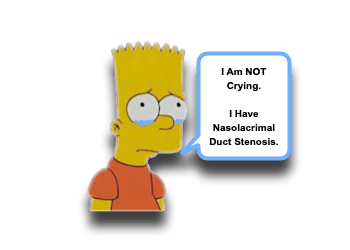Nasolacrimal Duct Obstruction

Neonates do weird things. Some of these things are normal… and some are not. While it is true, that you should “never trust a neonate” (See ALTE / BRUE), there are sometimes when the odd is not cause for tremendous turmoil. One example is those pesky clogged tear ducts. Let’s take a moment to consider Nasolacrimal Duct Obstruction:
Nasolacrimal Duct Obstruction: Anatomy
- Tear ducts are complicated (as is much of the human body).
- Lacrimal System consists of: [Orge, 2014]
- Lacrimal Gland – an exocrine gland with 2 lobes nestled in the frontal bone
- Lacrimal ducts – secrete the aqueous portion of tears
- Accessory Lacrimal Glands of Krause and Wolfring – located within the conjunctival fornices
- Puncta – located on the nasal corner of the upper and lower eyelids; serves as the exit point for tears
- Ampulla – extend vertically from each puncta
- Canaliculi – extend perpendicularly to the ampulla and meet to form the common canaliculus, which open into the lacrimal sac medially.
- Lacrimal Sac – runs vertically
- Nasolacrimal Duct – connects lacrimal sac to nasal cavity as it empties into the inferior nasal meatus (why your nose runs when you cry)
- Valve of Hasner – a mucosal flap that separates nasal cavity from the nasolacrimal duct; one way valve.
- Tear Drainage is also complex: [Orge, 2014]
- Tears do not simply drain by gravity.
- Opening and closing the eyes (AKA, Blinking), literally, generates both negative and positive pressures within the system that pumps tears through it.
- Lacrimal System consists of: [Orge, 2014]
Lacrimal System: What Can Go Wrong
- Congenital Nasolacrimal Duct Obstruction [Orge, 2014]
- Nasolacrimal Duct Obstruction (NLDO) is the most common lacrimal system problem.
- Occurs in ~6% of all newborns!
- Incomplete canalization of the nasolacrimal duct creating an imperforate Valve of Hasner is a common cause.
- Infants present after tear production matures (~6 weeks of life).
- BONUS MORSEL:
- Neonates may cry vigorously, but not produce tears!
- Presents as increased tearing, matted eyelashes, mucoid discharge from tear stasis.
- Distinguished from conjunctivitis as there is no light sensitivity and no bulbar conjunctiva redness (the eyes are still white).
- “Dye Disappearance Test” can help also:
- Normally, fluorescein stained tears should disappear within 5 minutes as the tears eventually flow away.
- With Nasolacrimal Duct Obstruction, the stained tears persist.
- Treated with:
- Digital massage in a downward motion starting from the puncta toward the lacrimal sac and nasolacrimal duct. Increased pressure my open the obstructed valve.
- Occasional topical antibiotic drops to help control the bacterial overgrowth in the stagnant tear pool (sounds like name of a 80’s grunge band).
- Occasionally, surgery / procedure is required to open the obstruction and may done endoscopically or even be done in the office setting. [Galindo-Ferreiro, 2016; Miller, 2014; Lee, 2012]
- Congenital Dacryocystocele [Orge, 2014]
- Present as a bluish mass overlying the area of the lacrimal sac or below the medial canthus.
- Noted soon after birth.
- Is an out-pouching of the lacrimal sac and duct.
- Associated with increased tearing, local inflammation, local infection, and cysts.
- May cause respiratory distress if it is bilateral (as neonates are obligatory nasal breathers).
- Often resistant to conservative therapy. Start with massage and topical antibiotics, but surgery may be needed.
- Dacryocystitis [Orge, 2014]
- Infection of the Lacrimal Sac.
- Most commonly due to chronic tear stasis from Congenital Nasolacrimal Duct Obstruction
- Distinguished by erythema and swelling below the medial cantonal area.
- May be painful, but can also be painless.
- Treat with warm compresses and oral antibiotics (against Strep and Staph).
- Surgical drainage and repair is rarely needed.
- Dacryoadenitis [Orge, 2014]
- Inflammation of the Lacrimal Gland.
- May be due to noninfectious reasons – malignancy
- May be due to infectious reasons – EBV, Tuberculosis, local trauma related infection
- Canaliculitis [Orge, 2014]
- Infection of the canaliculus by viruses, bacteria, or fungi.
- Mucopurulent conjunctivitis and drainage are seen.
- Compression of the canaliculus can express more purulent material (gross).
- There is no lacrimal sac distention like in dacrocystitis.
- Treat with warm compresses, digital massage, and antibiotics (topical may be effective alone).
- Occasionally need punctual curettage to remove stone.
- Acquired Punctal or Canalicular Stenosis [Orge, 2014]
- Acquired stenosis may result from viral infections (like varicella).
- Trauma and localized masses can also obstruct the delicate drainage system.
Moral of the Morsel
- The human body is complex in almost every detail! Simple tear production and management isn’t all that simple really.
- Not everyone cries. Especially Neonates… may take up to 6 weeks before they develop the ability to make tears!
- Not all matted lashes are due to conjunctivitis! Think about clogged tear ducts and recommend gentle massage.

